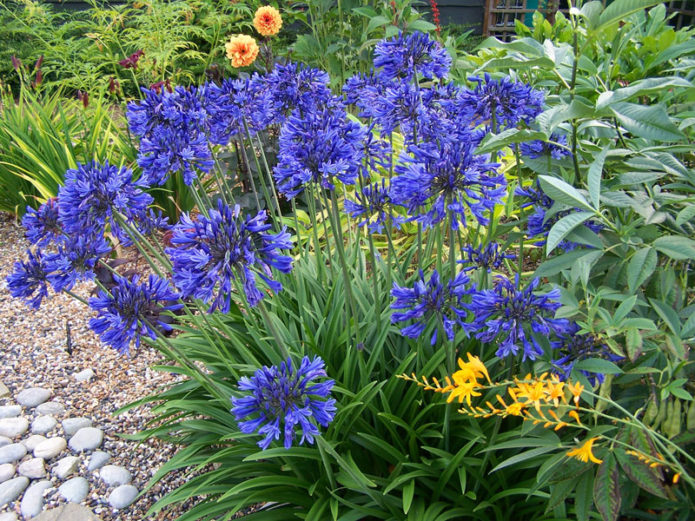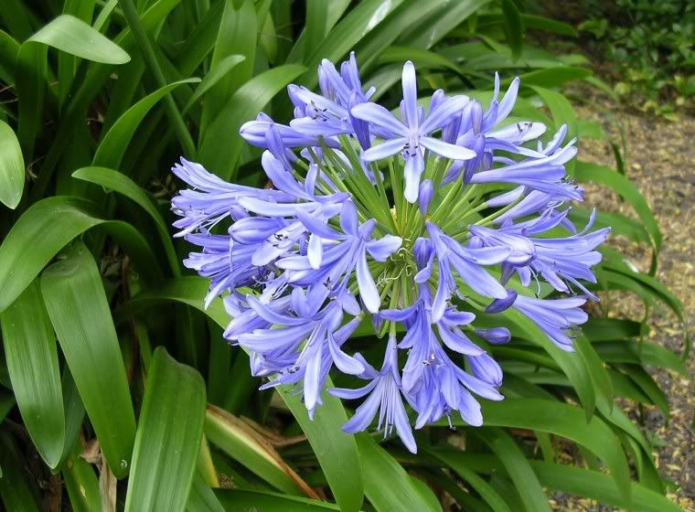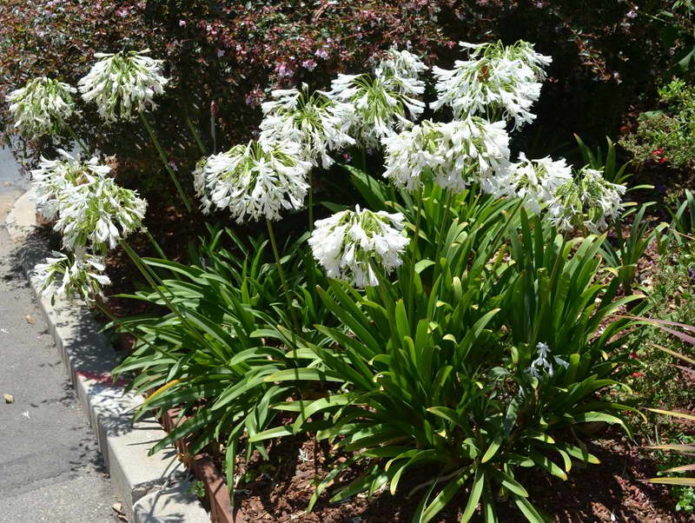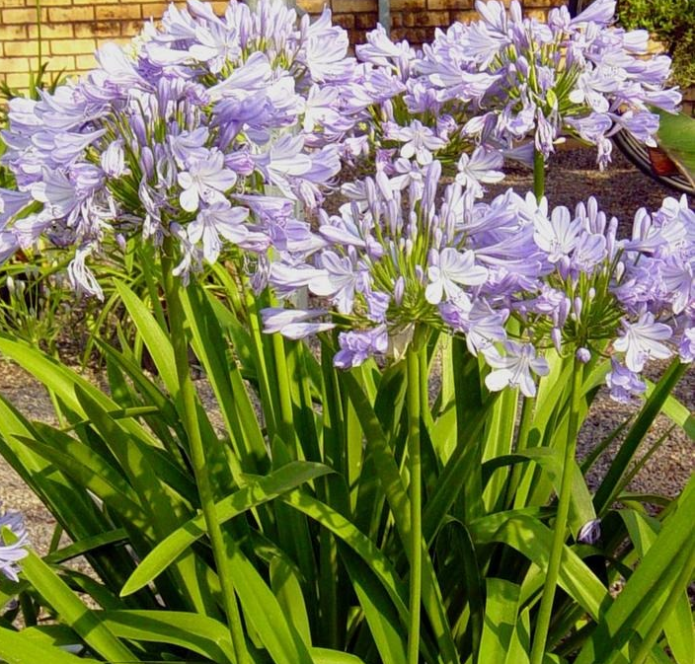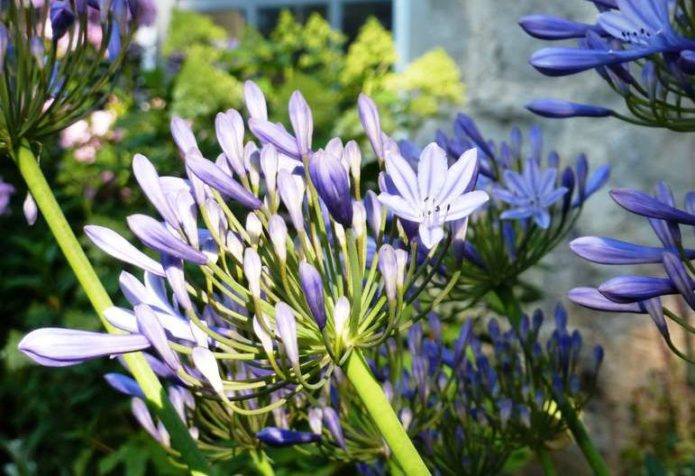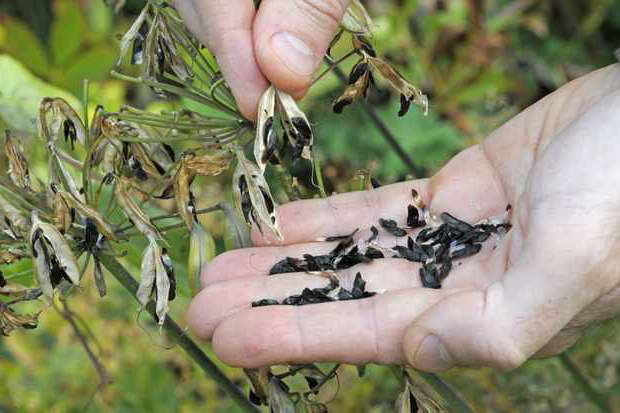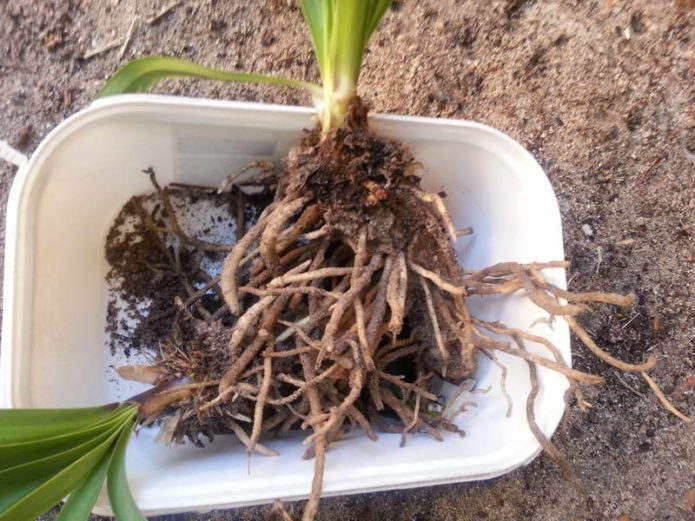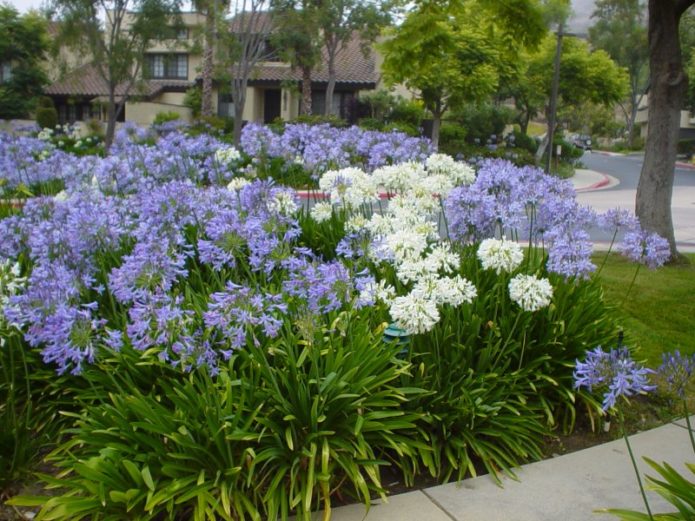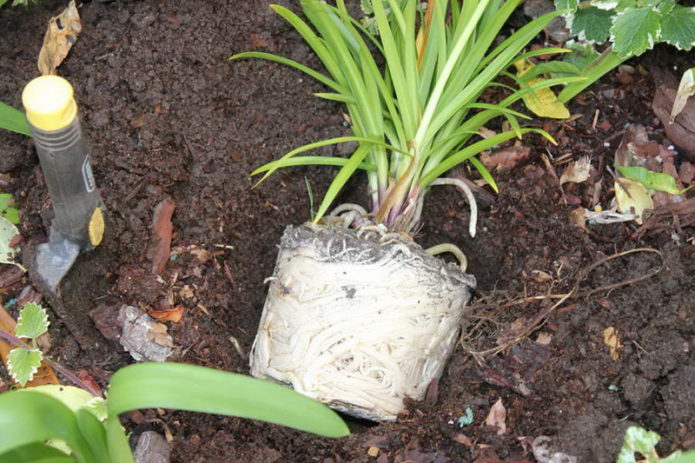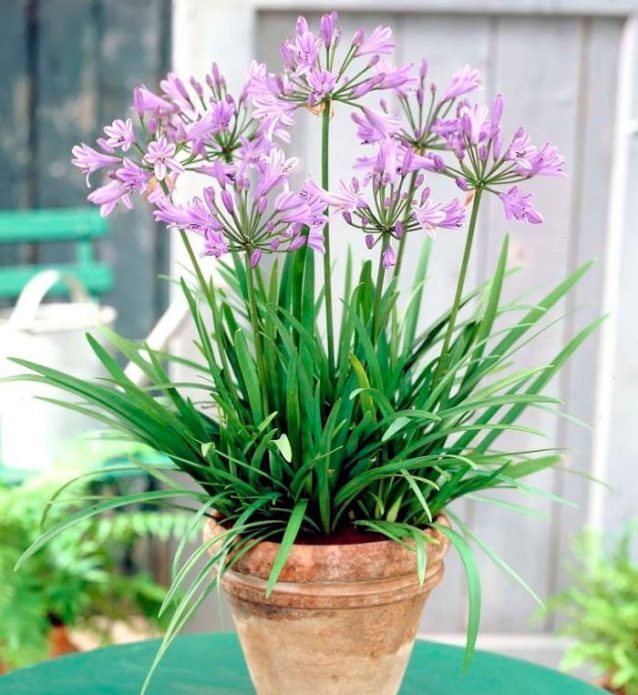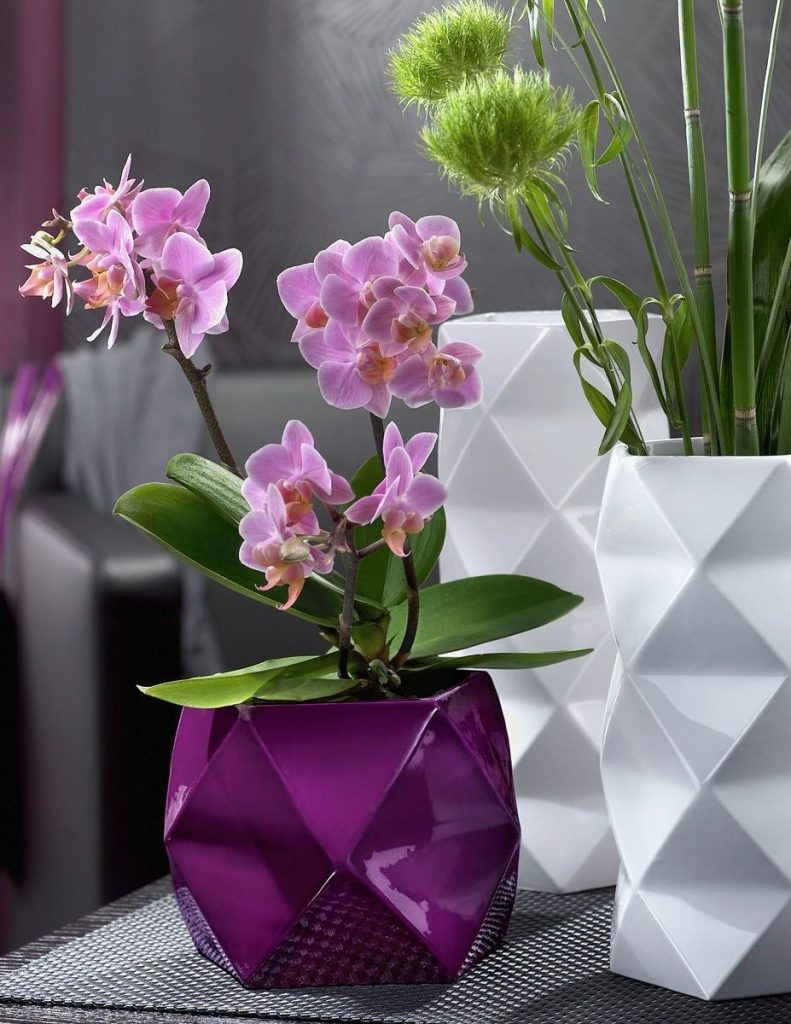Agapanthus is a perennial herb from the Agapantov family. The people also call it the African lily. Such a representative with abundant foliage of a deep green color and spectacular flowers exuding a pleasant aroma will harmoniously fit into any garden landscape and home interior. This is due to the fact that the culture can be grown both in the open field and on the windowsill.
Content
Features of growing in our latitudes
Agapanthus is native to South Africa. This is related to its extreme heat-loving nature. The plant has a well-developed creeping root system close to the ground. Its crown is formed by narrow 70-centimeter dark green leaves. Agapanthus blooms for a long time - from early July to October, which is due to the non-simultaneous dissolution of flowers. During this period, the African lily produces a powerful peduncle with a length of 60 to 120 cm with large inflorescences in the form of balls. They consist of funnel-shaped buds that look like bells. They are available in white, purple, light blue or blue. After flowering, fruits with seeds are formed on the plant.
In central Russia, agapanthus is grown mainly at home, as it is not able to withstand severe winters. The only thing is that it can be buried in the garden in the summer season, and then at the very height of it. And with the onset of cold weather, the plant is removed, planted in containers and transferred to a dark and cool room, where the temperature is kept within 12-15 ° C. And in the southern regions, it is successfully cultivated in gardens, where it hibernates under an appropriate shelter (a layer of peat, humus or sawdust).
Agapanthus growing on a windowsill has not only a decorative function. It is able to extract heavy metals and pathogenic bacteria from the air.
Agapanthus is used in landscape decoration as the main element of various flower arrangements. It is recommended to plant it with plants that bloom at the beginning of the summer season. They also decorate borders, terraces and gazebos. Some flower growers install flowerpots with agapanthus on the street.
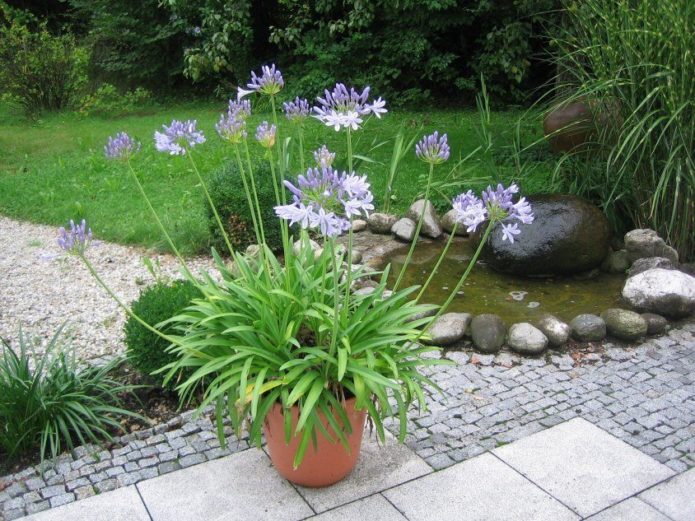
In summer, agapanthus is taken out into the street in pots, and in the winter they are brought back into the room.
Types and varieties of agapanthus with a photo
Breeders have bred many hybrid forms of agapanthus, more adapted to home cultivation and more diverse in the color range of buds. Otherwise, they are practically the same.
The most common types:
- Agapanthus umbellatus (Agapanthus umbellatus) is a plant up to 70 cm high with a dense leaf rosette. Its leaves are wide linear in shape, about 60 cm long. A groove is clearly traced in the center of the leaf plate. This representative blooms with blue spherical inflorescences up to 45 cm in diameter. Each bud contains 6 petals. The species is suitable for growing outdoors.
- Oriental agapanthus (Agapanthus orientalis) is a herbaceous perennial with belt-like leaves 50-60 cm long. The bush acquires a special decorative effect during flowering (in July-August), when the tops of the shoots are crowned with large lush inflorescences of a sky-colored color.
- African agapanthus (Agapanthus africanus) is a medium-sized evergreen herb with light green leaves along which a white stripe runs. Its flowers are mostly blue or blue, but among the hybrids there are specimens with white and lilac inflorescences.
- Bell agapanthus (Agapanthus patens) is a low-growing perennial no more than 15 cm high. It is ideal for growing in a flower pot on a windowsill. The plant owes its name to the bell-shaped flowers, which are light blue or blue in color.
Decorative forms of agapanthus, suitable for growing at home and on a personal plot:
- Blue Peter is an umbrella variety. Its stem reaches a meter in height, and the flowers-bells of a deep blue color are collected on the tops in lush inflorescences.
- Variegata is a flower with sky-blue buds and green narrow leaves, along which a white stripe runs.
- Albidus is a tall variety with spectacular white flowers with scarlet blotches on the perianth.
- Albus is a dwarf representative up to 20 cm high. It blooms with snow-white bell buds.
- Lilliput is a thirty-centimeter plant with an unusual purple-black color of lily-shaped flowers.
- Peter Pen is a compact variety with blue, funnel-shaped buds.
- Star Quality is a specimen characterized by bare meter-long shoots. It blooms with blue, purple or cream buds. This variety is grown mainly for cutting.
Features of growing agapanthus on the site
Agapanthus in the open field can be grown by reproduction. There are three ways:
- seeds;
- dividing root rosettes;
- shoots.
From seed
With this method, you must first grow seedlings. And sowing is done in March... For this, wide boxes are prepared. A mixture of sand with peat or leaf humus, taken in equal proportions, is suitable as a soil.
They act as follows:
- First, the seeds are soaked for 2 hours in cool water.
- A drainage layer (2–4 cm thick) of expanded clay or brick chips is poured onto the bottom of the container, then the substrate is laid out and moistened.
- Seeds are evenly distributed without deepening and sprinkled with earth. After that, the surface is lightly slapped with the palm.
- Cover the box with foil or glass to create a greenhouse effect. The seedlings are placed on a well-lit windowsill protected from direct sunlight.
The optimum temperature for germinating seeds is 23–25 ° C. It is necessary to open the protection daily for spraying crops with water and ventilation. The first sprouts hatch after 2 weeks, after which the glass (film) is removed. As soon as 4 leaves are formed, they begin to pick the seedlings with transplanting in separate cups. This usually happens in mid-May. 2 weeks before transplanting into open ground, the seedlings begin to harden: they are taken out into the fresh air every day, starting at one hour and gradually increasing the period to 10-12 hours.
Transplanting seedlings into the garden is planned for a time when the soil is fully warmed up and stable warm weather will be established outside without night frosts.On the garden bed, the sprouts are planted in holes 8–10 cm deep and at a distance of 40–50 cm from each other. Then the planting is mulched. And if planted in a flowerpot, place 2-4 pieces. together. When working, it is important to be careful with the root system of plants, as it is easily damaged.
After planting in open ground, the first flowering should not be expected earlier than in 5-6 years.
By dividing the rhizome
Reproduction of agapanthus by dividing the roots is carried out in early spring during transplantation or in autumn. This is done only with adult bushes and with a frequency of 1 time in 3-4 years.
Sequence of steps:
- Dig up the plant, trying to remove the root ball completely.
- Shake it off the ground and cut it into several pieces with a sharp tool. Each division should have developed root shoots, growth buds and several leaves.
- Sections are treated with crushed activated carbon.
- The cuttings are wrapped in a damp cloth and left for 2-3 days, then they are planted in the ground.
The first days, the sockets are watered minimally, and after they are rooted, they produce full moisture.
Shoots
In an adult agapanthus, young shoots - daughters - are formed at the base of the rosette. They can be detached and planted separately, resulting in a full-grown plant. Only in this case, they act extremely carefully so as not to injure the roots of the mother bush. Otherwise, he will die.
Care
The nuances of planting and caring for agapanthus in open ground are primarily based on the issue of lighting. Agapanthus is extremely light-loving and, with insufficient natural light, it loses the rich color of the foliage, and the peduncles are greatly stretched and thinned. Then the flowers will need a support. Therefore, the site is selected sunny, but with protection from the midday heat and draft.
The main care for agapanthus is as follows:
- The plant is actively watered throughout the growing season (until October). In hot weather, they do this twice a day - in the morning and in the evening. The main thing is that the soil is always damp. After the last bud dries up, watering is completely stopped, since the culture begins a dormant stage.
- Top dressing is applied every 14 days. They use complex mineral compositions and organics (one by one), previously diluted with water. In order not to burn the roots, fertilize the plant after watering. From late autumn to spring, agapanthus is stopped feeding.
Flowering and resting period
During the laying and opening of buds, the plant spends a lot of energy, therefore it is necessary to help it by abundant watering and making special dressings to stimulate flowering. And also it is necessary to systematically loosen the ground near the bushes and remove weeds that draw out many useful elements from the soil. When watering, they try to prevent drops from falling on the buds, which leads to their premature wilting.
If the agapanthus remains to winter in the open field, then it is covered with a wooden box or cardboard box and covered with spruce branches with sawdust. But most gardeners do not risk it and dig up the plant along with the soil, then place it in a container and bring it indoors.
Transfer
An adult agapanthus does not tolerate a transplant, so it is not recommended to resort to it often. If necessary, it is permissible to carry out the procedure no more than once every 3 years. But young plants are not as sensitive to changes in location.
Agapanthus at home
If the flower was bought in winter, then it is important to protect it from the cold when transporting it home. Even short cooling can lead to frostbite of the plant. Therefore, they wrap it up with paper or cellophane, and do not remove the packaging immediately when it is warm.Leave the newcomer for several hours for acclimatization. Then the agapanthus is quarantined for 10-15 days to protect other indoor plants from possible diseases and pests. For the sake of prophylaxis, the flower is treated with any fungicidal preparation.
At the time of adaptation, the flower is not moved, it is watered to a limited extent and is not fed with anything. The permissible temperature of the content is 22 ° C.
After the due date, the plant is transplanted into a new pot with enriched soil. Universal mineral mixtures are used as fertilizers. A layer of drainage from rubble or small pebbles is poured onto the bottom of the container.
Table: optimal growing conditions for a flower, depending on the season
| Season | Temperature | Humidity | Lighting | Location |
| Spring Summer | + 22-25 ° C (in summer, the plant is taken out to the balcony or garden and left overnight) | A moderate air humidity of at least 40% is required, for which the flower is sprayed daily | Bright but protected from direct sunlight | South, west and east window sills |
| Autumn winter | 15 ° C | No additional hydration required | Shaded | Near the north-facing windows |
The rest of the care for indoor agapanthus is the same as on the street:
- watered abundantly in spring and summer, but without creating swampiness;
- are fed with mineral fertilizers 2 times a month.
Agapanthus is not particularly sensitive to irrigation water, but it is recommended to pre-settle it at room temperature.
Diseases and pests
Agapanthus rarely gets sick and only because of mistakes in care. With excessive watering, the roots begin to rot, which is manifested by yellowing and foliage falling. To prevent this, you must strictly adhere to the rules: in the summer, water regularly and moderately, in the winter - as the upper soil layer dries out completely. To save the plant, a transplant will be required with the preliminary removal of rotten roots.
The appearance of yellowness on the leaves indicates waterlogging of the soil. To stabilize the situation, you need to adjust the irrigation mode. If the stems grow intensively and become thinner, then the reason is a lack of light.
For agapanthus growing in open ground, pests are dangerous:
- spider mite;
- shield;
- aphid;
- mealybug;
- slugs and snails.
They get rid of them mechanically: they wipe the plant with a napkin dipped in alcohol or soapy water. After that, the sockets are treated with insecticidal preparations (for example, Aktara). Slugs and snails are removed by hand or scattered under the eggshell flowers.
Agapanthus fell in love with flower growers and gardeners for its long colorful flowering. These perennials will take the lead in any composition. But even in single copies, they become a worthy decoration in the house. And the variety of varieties allows you to satisfy even the most demanding summer residents. For the successful cultivation of agapanthus, it is enough to create favorable conditions and minimal care for it.
